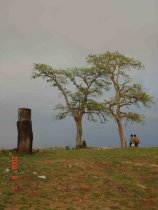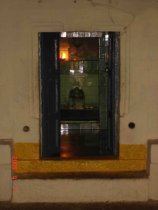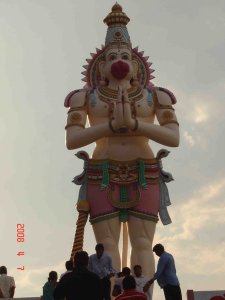
Charminar is always on the top of the mind of any tourist visiting Hyderabad. To say that Charminar is a major landmark in the city is to state the obvious, to repeat a cliché. The great monument is a synonym for Hyderabad and the pivot around which the glory and history of the city have developed. To imagine this 400-year-old city without Charminar is to imagine New York without the Statue of Liberty or Moscow without the Kremlin. Built by Mohammed Quli Qutub Shah in 1591, shortly after he had shifted his capital from Golkonda to what now is known as Hyderabad, this beautiful colossus in granite, lime, mortar and, some say, pulverised marble, was at one time the heart of the city. This great tribute to aesthetics looks sturdy and solid from a distance but as one moves closer, it emerges as an elegant and romantic edifice proclaiming its architectural eminence in all its detail and dignity. Apart from being the core of the city’s cultural milieu, it has become a brand name.
 Charminar is a squarish structure with four towers in the four corners of the square, each of whose sides is 20 metres in length. Every side opens into a plaza through giant arches, which overlook four major thoroughfares and dwarf other features of the building except the minarets. Each arch is 11 metres wide and rises 20 metres to the pinnacle from the plinth. The minarets soar skywards by 24 metres from the roof of Charminar. Each minaret has four storeys, each looking like a delicately carved ring around the minaret. Some Anglophiles call Charminar the Arc de Triomphe of the East. From the ground to the apex, the minarets cover a length of 48.7 metres.
Charminar is a squarish structure with four towers in the four corners of the square, each of whose sides is 20 metres in length. Every side opens into a plaza through giant arches, which overlook four major thoroughfares and dwarf other features of the building except the minarets. Each arch is 11 metres wide and rises 20 metres to the pinnacle from the plinth. The minarets soar skywards by 24 metres from the roof of Charminar. Each minaret has four storeys, each looking like a delicately carved ring around the minaret. Some Anglophiles call Charminar the Arc de Triomphe of the East. From the ground to the apex, the minarets cover a length of 48.7 metres.
According to Mir Moazzam Husain, a long time official of the UNESCO and a keen student of this historic city, “these minarets may even symbolise the first four khalifs of Islam, but I cannot vouch for this interpretation with any degree of certainty.” At the western end of the roof of Charminar is a beautiful mosque; the oldest in Hyderabad, and the rest of the roof was used as a court in Qutub Shahi times. Atop the great monument are 45 prayer spaces for the devout where they can offer worship in an atmosphere unspoilt by the bustle of the city. East of this space is a spacious verandah with small and large arches in the middle. The first floor has beautiful balconies from where one has a fantastic view of the historic city and its later accretions.















































